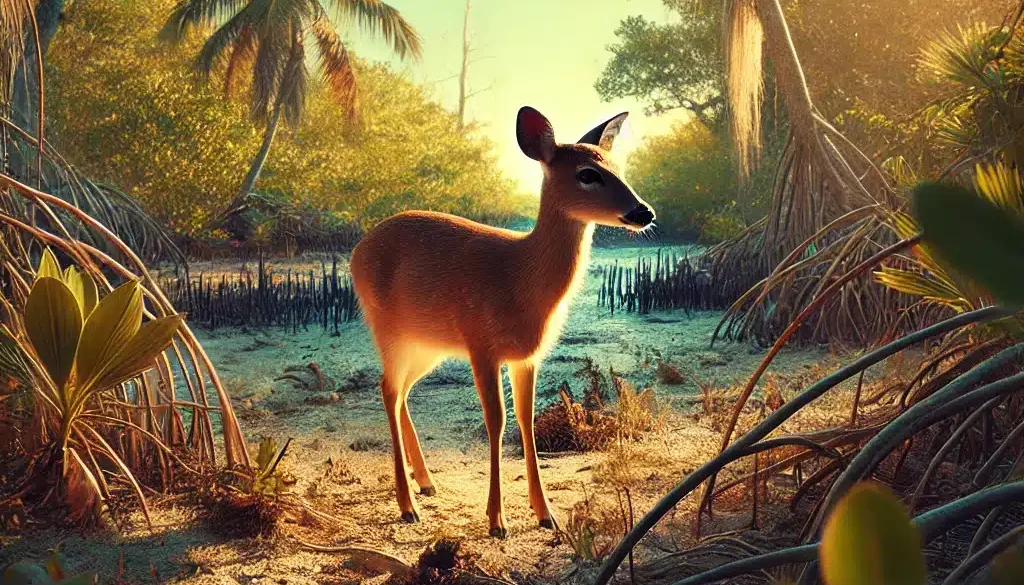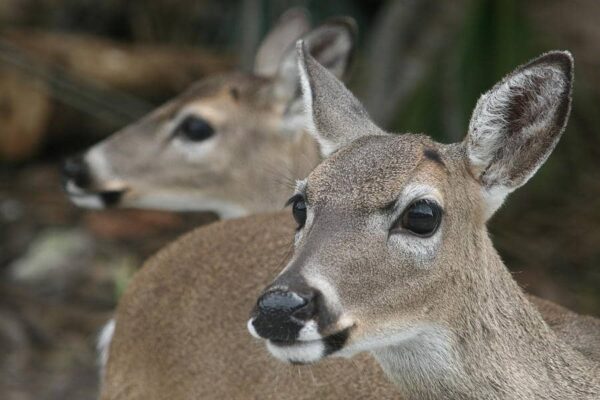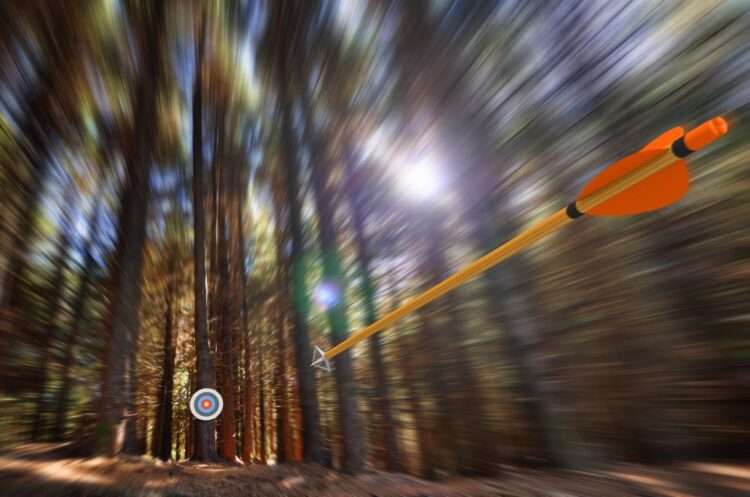The Florida Keys is one of the most beautiful and unique places in the United States. Located off the southernmost tip of Florida, its turquoise waters are inviting for visitors and creatures alike. But deer? Really?

Amidst this natural wonderland, a captivating creature reigns supreme – the Key deer. These diminutive and endearing creatures are native to these islands and hold a significant place in the delicate web of life within the Florida Keys ecosystem.
Key Deer Overview
The Key deer is a subspecies of white-tailed deer and is one of the smallest species of deer in North America. Adult key deer typically weigh about two to three feet tall at the shoulder and weigh between 60 and 90 pounds. They possess distinct physical features that distinguish them from their larger counterparts.
One notable characteristic is their large ears, which serve multiple functions such as heat regulation and enhanced hearing capabilities. Additionally, they have shorter tails compared to other deer species.
Importance of Key Deer in the Florida Keys Ecosystem
The presence of Key deer in the Florida Keys ecosystem holds immense ecological importance due to its role as both prey and predator. As herbivores, they play a crucial role in shaping vegetation communities through selective browsing of various plants and fruits.
By consuming specific plant species, they indirectly impact seed dispersal patterns across different island habitats. Furthermore, Key deer are an integral part of the food chain within their habitat.
They provide sustenance for apex predators such as panthers and alligators while also serving as prey for medium-sized predators like bobcats or coyotes that occasionally venture into their range from mainland Florida.
Beyond their ecological significance, the Key deer holds a deep cultural and historical significance for the people residing in the Florida Keys.
They are considered an iconic species and have become a symbol of conservation efforts for this unique island chain, serving as a testament to nature’s resilience and interconnectedness.
General Characteristics of Key Deer

Key deer, scientifically known as Odocoileus virginianus clavium, are a subspecies of the white-tailed deer found exclusively in the Florida Keys. These magnificent creatures possess distinct features that set them apart from their mainland relatives.
They are smaller than other white-tailed deer, with an average height ranging between 24 and 32 inches at the shoulder. Typically, adult males weigh around 80-100 pounds, while females tend to be slightly lighter at 60-80 pounds.
Physical Appearance and Size
Certain notable traits characterize the key deer’s physical appearance. One striking feature is their large ears, which serve multiple purposes.
Aside from enhancing their hearing abilities for detecting predators or locating mates, these prominent ears also assist in thermoregulation, allowing them to dissipate excess body heat in the subtropical climate of the Florida Keys. Furthermore, key deer possess a short tail measuring only about four inches long on average.
Habitat Preferences and Range
The Florida Keys archipelago provides a unique habitat range for key deer. Within this tropical paradise, they primarily inhabit two specific islands: Big Pine Key and No Name Key.
These islands offer diverse ecosystems that cater to various aspects of key deer survival needs. Key deer’s preferred habitats encompass pine rocklands and hardwood hammocks.
Pine rocklands are characterized by open savannas interspersed with towering slash pines and lush understory vegetation such as saw palmetto and wildflowers. On the other hand, hardwood hammocks consist of dense canopies dominated by trees like gumbo-limbo and pigeon plum.
This subspecies has developed distinct adaptations within these habitats to withstand environmental challenges such as limited freshwater sources, hurricanes, and changes in vegetation patterns. Their ability to thrive in these specific ecosystems makes key deer an integral part of the delicate balance of the Florida Keys’ biodiversity.

Life Cycle and Behavior of Key Deer
Reproduction and Mating Habits
Subtly alluring rituals that dance under the moonlight. The key deer, known for its graceful presence and rare beauty, follows a remarkable reproductive cycle.
Their mating habits are awe-inspiring, reflecting a delicate balance of instinctual behavior and courtship rituals. The breeding season for these majestic creatures typically occurs between October and December when the weather is cooler.
During this time, male and female key deer engage in an elaborate courtship dance, where males showcase their strength through spirited battles with rivals. These skirmishes involve locking antlers and pushing against each other with great force to establish dominance over potential mates.
Gestation Period and Birth Process
It is a miraculous journey from conception to creation. Once courtship has led to successful mating, female key deer undergo a gestation period of approximately 204-220 days. This duration is an extraordinary testament to the patience to nurture new life within the womb.
As the pregnancy nears its end, expectant mothers seek out secluded areas within their preferred habitats to give birth—a process known as parturition. Often choosing dense vegetation or shaded areas amidst hardwood hammocks or pine rocklands, they create safe havens for their upcoming arrivals.
Number of Offspring per Pregnancy
Nature’s generous gift wrapped in innocence. A mother key deer brings new hope for preserving their species with each pregnancy.
Typically giving birth to a single fawn at a time, these miniature marvels embody vulnerability and wonderment. Occasionally, twins may grace this world side by side if conditions are favorable during conception or gestation; however, such occurrences remain relatively rare compared to single births.
Maternal Care for Newborns
A tender embrace that nurtures the future. Once a delicate fawn enters the world, their survival depends on their devoted mothers’ unwavering care and protection. Female key deer exhibit exceptional maternal instincts, dedicating themselves to nursing and safeguarding their young ones.
In the early weeks of life, fawns rely solely on their mother’s milk for sustenance. As they grow stronger and more independent, mothers gradually introduce them to a specialized diet of plants, fruits, and tender vegetation.
Feeding Habits
A culinary exploration amidst nature’s pantry. Key deer possess a diverse palate shaped by their unique habitat preferences. These elegant creatures have adapted to thrive in an environment rich with plant life across the Florida Keys.
They predominantly feed on foliage like leaves, twigs, grasses, and blossoms from native plants such as mangroves, sea grapes, and thatch palms. Additionally, they relish fruits like blackberries during certain seasons when these delectable treats become available in abundance.
Key deer showcase remarkable browsing behavior as they carefully select the tenderest parts of vegetation without causing severe damage or depletion to their surroundings—a testament to their harmonious relationship with nature. As we immerse ourselves in understanding the intricacies of key deer’s life cycle and behavior, we unravel a tapestry woven with tales of love, birth, nurturement, and gastronomical delights—the captivating essence of this remarkable species that continues to enchant all those who encounter it within its natural habitat.
Key Threats to the Key Deer Population
Habitat loss due to human development
The pristine beauty of the Florida Keys has long attracted human settlement and development, resulting in the gradual encroachment on the natural habitats of key deer. As urbanization continues, vast stretches of land have been transformed into residential and commercial areas, causing a significant reduction in suitable habitats for these majestic creatures.
Converting forests and meadows into concrete jungles disrupts the delicate balance necessary for key deer survival. The construction of roads, buildings, and other infrastructures fragments their habitat, leaving them limited access to food resources and breeding grounds.
Impact of urbanization on their natural habitat
The rapid growth of urban areas within the Florida Keys has had profound implications for key deer populations. Urbanization brings noise pollution, increased traffic volume, and artificial lighting that disrupts their natural behaviors.
These factors disturb key deer’s ability to communicate effectively and alter their movement patterns as they attempt to navigate increasingly crowded landscapes. Furthermore, expanding human settlements often results in more encounters between humans and key deer, leading to potential conflicts that can endanger both parties.
Consequences of habitat fragmentation on their movements
Habitat fragmentation caused by human development poses a significant threat to the survival of key deer populations. Once contiguous habitats are divided into isolated patches by roads or structures, it becomes increasingly challenging for key deer to move freely across their territory in search of food, mates, and suitable shelter.
Fragmentation disrupts important ecological processes, such as gene flow between populations, which can weaken genetic diversity and increase vulnerability to disease. Moreover, fragmented habitats limit access to essential resources during different seasons or environmental conditions when certain areas may provide better sustenance or protection.
Predation risks from non-native species
In addition to the challenges posed by habitat loss, key deer face predation risks from non-native species introduced to the Florida Keys. One notable example is the presence of feral cats and dogs, which compete with key deer for limited resources and act as predators. These introduced species lack natural predators, causing their populations to grow unchecked.
The increased predation pressure threatens key deer survival, particularly during vulnerable life stages such as reproduction and early development. Introducing non-native predators disrupts the delicate ecological balance that has evolved over millennia without such threats.
Introduction of predators such as feral cats or dogs
Introducing feral cats and dogs into the natural habitats of key deer has had far-reaching consequences for their population dynamics. These domesticated animals turned feral and exhibited hunting instincts that target small mammals like key deer.
Their predatory behavior directly impacts adult key deer and poses a significant risk to newborns and juveniles, who are more susceptible to predation due to their size and relative defenselessness.
These introduced predators create an imbalance within the ecosystem, leading to potential population declines if left unchecked. With these significant threats looming over their population, proactive conservation efforts become paramount in safeguarding the future existence of this unique species in a rapidly changing world.
Conservation Efforts for Key Deer Preservation

The Key deer has been recognized as endangered by the U.S. Fish & Wildlife Service since 1967. This designation provides legal protection and allows for the implementation of conservation efforts to safeguard their population.
The decision to list them as endangered was based on several factors, primarily their restricted range and vulnerability to habitat loss, predation risks, and human activities.
The rationale behind the listing
The rationale behind designating Key deer as an endangered species lies in their unique ecological significance within the delicate Florida Keys ecosystem.
As keystone species, they play a crucial role in maintaining biodiversity by dispersing seeds and controlling vegetation growth through browsing. Protecting Key deer populations preserves these fragile island habitats’ overall health and balance.
Protective measures implemented under this designation
Various protective measures have been implemented under their endangered status designation to ensure the survival of Key deer. Habitat preservation is prioritized through land acquisition programs to secure key areas of their natural habitat from further development.
Additionally, strict regulations are enforced to prevent illegal hunting or harm to these animals. Creating wildlife corridors and fencing systems helps mitigate road mortality risks associated with collision accidents.
Human intervention programs
Besides legal protections, numerous human intervention programs contribute significantly to Key deer preservation efforts.
These initiatives include captive breeding programs, which focus on increasing population numbers and genetic diversity through controlled breeding in specialized facilities.
Additionally, public education campaigns raise awareness about responsible human behavior towards wildlife and emphasize the importance of conserving this iconic species.

Conclusion
Despite facing numerous threats, such as habitat loss and predation risks from non-native species, significant conservation efforts have been implemented to protect the endangered Key deer.
The U.S. Fish & Wildlife Service’s designation has promoted the establishment of protective measures, including habitat preservation, legal regulations, and human intervention programs.
These collective efforts provide hope for the future of Key deer populations and inspire optimism that we can secure their existence through continued conservation endeavors for generations to come.






